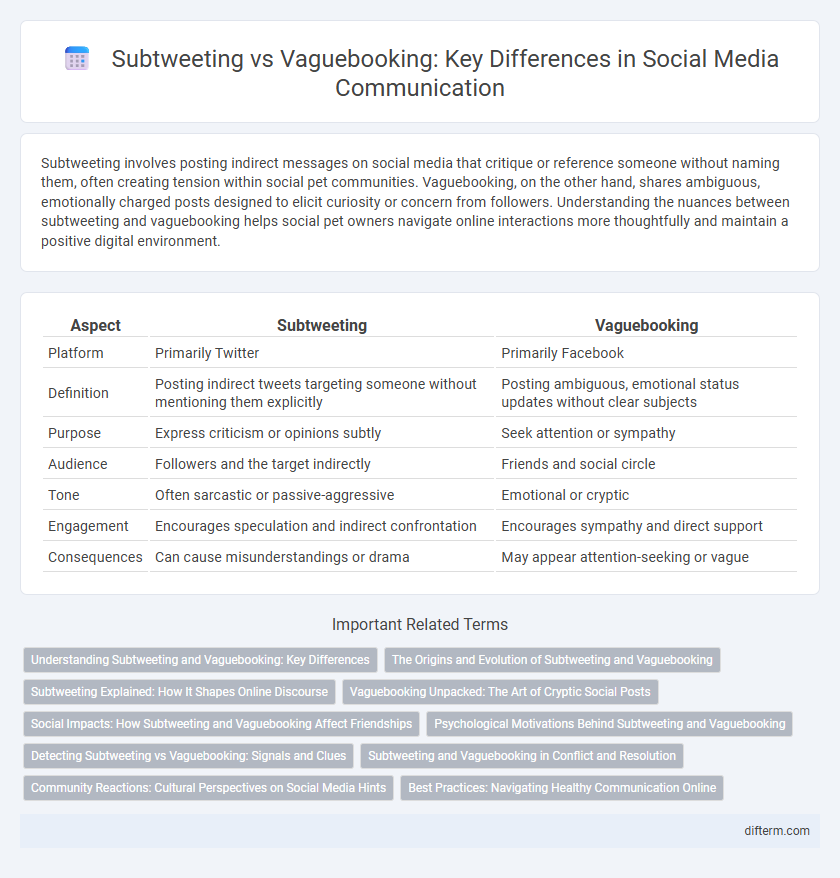Subtweeting involves posting indirect messages on social media that critique or reference someone without naming them, often creating tension within social pet communities. Vaguebooking, on the other hand, shares ambiguous, emotionally charged posts designed to elicit curiosity or concern from followers. Understanding the nuances between subtweeting and vaguebooking helps social pet owners navigate online interactions more thoughtfully and maintain a positive digital environment.
Table of Comparison
| Aspect | Subtweeting | Vaguebooking |
|---|---|---|
| Platform | Primarily Twitter | Primarily Facebook |
| Definition | Posting indirect tweets targeting someone without mentioning them explicitly | Posting ambiguous, emotional status updates without clear subjects |
| Purpose | Express criticism or opinions subtly | Seek attention or sympathy |
| Audience | Followers and the target indirectly | Friends and social circle |
| Tone | Often sarcastic or passive-aggressive | Emotional or cryptic |
| Engagement | Encourages speculation and indirect confrontation | Encourages sympathy and direct support |
| Consequences | Can cause misunderstandings or drama | May appear attention-seeking or vague |
Understanding Subtweeting and Vaguebooking: Key Differences
Subtweeting involves posting indirect or hidden messages on social media that target specific individuals without mentioning them explicitly, often causing confusion or drama within social circles. Vaguebooking refers to sharing ambiguous, emotionally charged posts designed to provoke curiosity or sympathy from followers without revealing the full context. Understanding these distinctions highlights how subtweeting subtly conflicts with targeted individuals, while vaguebooking broadly seeks attention or emotional validation.
The Origins and Evolution of Subtweeting and Vaguebooking
Subtweeting originated on Twitter as a subtle way to criticize or address someone without directly mentioning their username, evolving alongside the platform's rise in the late 2000s. Vaguebooking emerged around the early 2010s on Facebook, characterized by intentionally ambiguous status updates designed to provoke curiosity or suspicion among friends. Both phenomena reflect the shifting social media strategies for indirect communication within digital communities.
Subtweeting Explained: How It Shapes Online Discourse
Subtweeting involves posting indirect or ambiguous messages targeting someone without mentioning them explicitly, creating a layer of social tension and speculation among online communities. This practice influences online discourse by encouraging passive-aggressive communication and fostering engagement through curiosity and interpretation. Unlike vaguebooking, which is more generalized and seeks broad emotional responses, subtweeting directly impacts the dynamics of interpersonal conflict and social signaling on platforms like Twitter.
Vaguebooking Unpacked: The Art of Cryptic Social Posts
Vaguebooking thrives as a form of cryptic social posting where users share ambiguous, emotionally charged updates designed to provoke curiosity without direct confrontation. Unlike subtweeting, which targets specific individuals through indirect mentions, vaguebooking employs general statements that invite broad interpretation and engagement from a wider audience. This artful ambiguity fosters speculation, driving interactions rooted in intrigue rather than explicit discourse.
Social Impacts: How Subtweeting and Vaguebooking Affect Friendships
Subtweeting often leads to misunderstandings and increased tension among friends by indirectly addressing conflicts without open communication, which can erode trust and intimacy. Vaguebooking creates ambiguity and curiosity, potentially causing anxiety or frustration as friends speculate about the vague posts' true meaning. Both behaviors can weaken social bonds, reduce transparency, and foster a culture of passive-aggressive interaction instead of fostering healthy dialogue.
Psychological Motivations Behind Subtweeting and Vaguebooking
Subtweeting and vaguebooking serve as indirect communication methods on social media, offering users a way to express emotions without direct confrontation. Both behaviors stem from psychological motivations such as the desire for attention, emotional validation, or passive-aggressive expression while avoiding the risks of open conflict. These platforms provide a sense of control and anonymity, enabling users to navigate complex social dynamics and manage interpersonal relationships subtly.
Detecting Subtweeting vs Vaguebooking: Signals and Clues
Detecting subtweeting involves identifying indirect mentions and insinuations aimed at specific individuals without naming them, often revealed through context clues like shared history or recent conflicts. Vaguebooking, characterized by ambiguous and attention-seeking status updates, can be spotted via generalized emotional expressions and an absence of clear targets. Key signals include the specificity of grievances in subtweets versus the broad, cryptic nature of vaguebook posts.
Subtweeting and Vaguebooking in Conflict and Resolution
Subtweeting and vaguebooking often intensify social conflicts by allowing indirect communication that fosters misunderstanding and speculation among peers. Subtweeting targets specific individuals covertly, escalating tension without direct confrontation, while vaguebooking broadcasts ambiguous grievances to a wider audience, prompting widespread gossip. Resolving these conflicts requires promoting clear, direct communication and encouraging accountability to dismantle the ambiguity that fuels social discord.
Community Reactions: Cultural Perspectives on Social Media Hints
Subtweeting and vaguebooking elicit distinct community reactions shaped by cultural contexts, with subtweeting often perceived as indirect confrontation within tighter social groups and vaguebooking seen as broader, less personalized expressions of discontent. In collectivist cultures, subtweeting may foster group cohesion by signaling insider knowledge, while vaguebooking tends to generate widespread speculation and diffuse social tension. These nuanced reactions highlight how social media hints function differently across cultural frameworks, impacting online community dynamics and personal relationships.
Best Practices: Navigating Healthy Communication Online
Subtweeting and vaguebooking often blur boundaries in online communication, risking misunderstandings and negative emotional impacts. Best practices encourage direct, respectful dialogue and clear expression to foster transparency and prevent conflict. Prioritizing empathy and mindfulness when posting enhances digital well-being and maintains genuine social connections.
subtweeting vs vaguebooking Infographic

 difterm.com
difterm.com